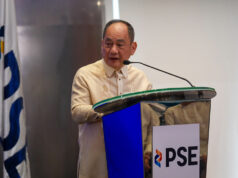Factory activity best in five months
By Elijah Joseph C. Tubayan
Reporter
PHILIPPINE manufacturing activity saw “solid improvement” in May, picking up for the third straight month on growing demand despite “intensified” cost pressures passed on to customers via higher prices, according to the latest monthly tracking IHS Market conducted for Nikkei, Inc.
The Philippines’ Purchasing Managers’ Index (PMI) rose to 53.7 in May from 52.7 in April, marking the highest reading for the year, so far.
The PMI consists of five subindices, namely: new orders, which has the biggest weight at 30%, output (25%), employment (20%), suppliers’ delivery times (15%) and stock of items (10%). It is based on data compiled from monthly replies to questionnaires sent to purchasing executives in over 400 industrial firms.
A reading of 50 separates those above that mark signaling expansion from the preceding month, from those below it denoting contraction.
”Growth in the Philippines manufacturing economy gained pace in the middle of the second quarter as demand conditions improved further. New business expansion picked up noticeably, encouraging factories to scale up production. Increased demand lifted purchasing activity which, in turn, boosted inventories,” the report read.
”Survey data showed further signs of improvement in client demand in the wake of the tax reform measures, which were put into effect at the start of the year. New business inflows grew at the fastest rate since November last year, even as export sales growth cooled.”
In the face of increased demand, firms ramped up production, resulting in the fastest output growth in five months.
However the report noted that the rise in input costs “intensified” last month, due to “supply shortages, a weaker peso, higher global commodity prices and tax reforms.”
“As a result, firms raised selling prices again, with the rate of increase remaining solid, reflecting efforts to pass on higher costs to their customers,” it said.
Republic Act No. 10963, or the Tax Reform for Acceleration and Inclusion Act (TRAIN) that is the first of up to five such system tweaks in the pipeline, slashed personal income tax rates and sought to offset the expected foregone revenues by hiking or adding taxes on several items and removing the value added tax exemption of various sectors when the law took effect on Jan. 1.
Some economists have blamed the TRAIN for pushing monthly inflation beyond the central bank’s 2-4% full-year target range in March (4.3%) and April (4.5%).
Bernard Aw, principal economist at IHS Markit, said in the report that improved demand showed that the “adverse impact caused by the new tax reforms has clearly subsided.”
However he added that inflation may still remain elevated, which will “raise expectations for another rate hike in June,” following the Bangko Sentral ng Pilipinas’ (BSP) 25-basis point hike last May 10 that was the first increase in nearly four years. The central bank’s Monetary Board is scheduled to review policy next on June 21.
The BSP said on Thursday that consumer prices likely picked up by 4.6-5.4% last month, surpassing April’s pace that was itself the fastest in more than five years.
Mr. Aw added that rising inflation pressures may take a toll on firms’ profit margins.
“PMI data showed firms raising selling prices at a slower rate in May amid rising costs, suggesting that companies may have a threshold of the extent to which their customers can bear higher prices without affecting demand. The good news is that improving demand conditions permitted firms to share some of the higher costs with their customers,” he said.
Michael L. Ricafort, economist at the Rizal Commercial Banking Corp., said in an e-mail on Friday that manufacturing’s continued improvement despite higher costs was a result of 2017’s record $10.049-billion foreign direct investments (FDIs). Such capital inflows, he explained, “fundamentally led to increased manufacturing activities, especially once some of these FDIs become completed/online”.
He added that consumers’ purchasing power remained strong, “resulting in higher consumer spending (which accounts for about 70% of the Philippine economy), especially on consumer-related industries that may have benefitted in terms of higher demand, sales, income, as well as increased production/manufacturing activities.”
Mr. Ricafort also noted that increased government spending, particularly on infrastructure, has supported manufacturing activities as well as the growth of the real estate and construction industry. Latest available data from the Budget department show overall state spending grew 29% year-on-year to P1.033 trillion while infrastructure and other capital outlays surged 47.5% to P222.7 billion in the four months to April.
Security Bank Corp. economist Angelo B. Taningco said in a separate e-mail that it was local inflation that led to softer exports of manufactured goods last month.
“I think the weakness in export orders was largely induced by domestic inflation increasing more than inflation in the export markets, leading foreign buyers to prefer less of Philippine manufactured products,” he said in an e-mail.
The latest Philippines PMI report noted that increase in hiring “remained fractional” in May despite higher sales, noting even “reports of staff cuts to reduce costs”.
Still, the report noted that business confidence about output in the next 12 months remained elevated, as majority of respondents surveyed said they are confident of faster output growth in the coming months due to product launches, new outlets, higher sales forecasts, promotional activity and increased productivity.



